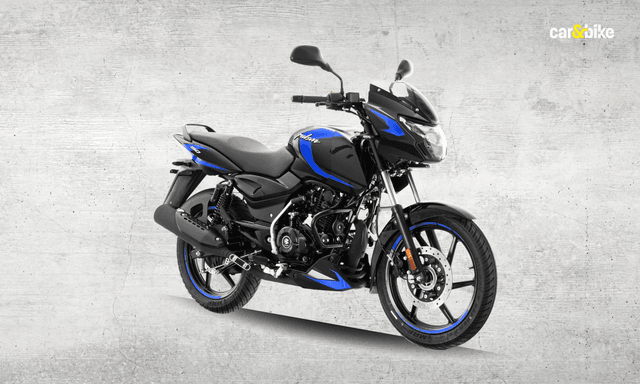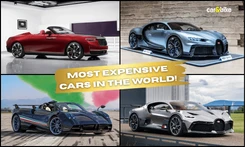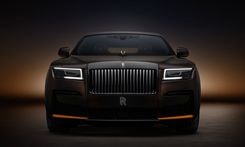Rolls-Royce To Realise Its Founders' Vision For Electric Mobility With Its First EV

- Rolls-Royce will reveal details about its first EV on September 29, 2021
- Charles Rolls & Henry Royce worked on EVs before starting Rolls-Royce
- Rolls-Royce has already shown two EV concepts in the past - 102EX & 103EX
Earlier in 2020, Rolls-Royce Motor Cars had announced the plan to launch its first-ever electric vehicle during the ongoing decade (2020 to 2030). The luxury carmaker did not reveal any specifics back then, now the company has confirmed that it will be making a major announcement regarding its first-ever electric vehicle later this week, on September 29, 2021. While it's now, in the 2020s that the company aims to bring in its first EV, one of its founders, Charles Rolls, had foretold that electrification of automobiles is the future in the 1900s, about 120 years ago.
Commenting on the announcement, Torsten Muller-Otvos, Chief Executive Officer, Rolls-Royce Motor Cars said, "In April 1900, our founding forefather, Charles Rolls, made a prescient prophecy about automotive electrification. Move forward over 120 years to when I made a public promise, on the record, that we would bring the first fully electric Rolls Royce to market within the current decade. And, right now, our company is embarking on an historic undertaking to create the first, super luxury car of its type. This will happen, sooner than many thought possible, through the incredible skills, expertise, vision and dedication of our engineers, designers and specialists at the Home of Rolls-Royce."

Torsten Muller-Otvos, Chief Executive Officer, Rolls-Royce Motor Cars says the company is embarking on an historic undertaking to create the first, super luxury electric car
Now, previously, Rolls-Royce had mentioned that it will launch its first electric vehicle only when the time is right, and every element meets Rolls-Royce's technical, aesthetic and performance standards. Furthermore, the company has also confirmed that the first electrified vehicle from Rolls-Royce will be a pure Battery Electric Vehicle (BEV) and not a hybrid of any kind. And to mark this major announcement, the company has decided to reveal how its founding fathers were already one of the pioneers in electric mobility, even before the inception of the luxury car marque.
Also Read: Rolls-Royce Reveals The New Boat Tail

Both Charles Rolls and Sir Henry Royce had individually worked on electric mobility before they founded the luxury car marque
Before the brand Rolls-Royce was founded, both Charles Rolls and Sir Henry Royce had individually worked on electric mobility. Characteristics like - silent operation, instant torque, tremendous power and the absence of exhaust fumes - were seen as ideal for luxury motor cars. However, they decided to make their own cars, they went with Internal Combustion Engines (ICE) over electric powertrains, mainly because of two reasons - extremely limited range and the absence of a charging infrastructure.

Charles Rolls, one of the founders of Rolls-Royce, wanted to make electric cars but felt they will not be very serviceable, at least for many years to come
In an interview published in The Motor-Car Journal in April 1900, Rolls described electric propulsion, in terms that, over a century later, carry the ring of prescient prophecy. He had said, "The electric car is perfectly noiseless and clean. There is no smell or vibration, and they should become very useful when fixed charging stations can be arranged. But for now, I do not anticipate that they will be very serviceable - at least for many years to come." Rolls even tried to solve the problem by providing a battery-charging station at his car showroom on Lillie Road in Fulham for the private or rentable electric Broughams that were all the rage in London at the time. In 1904, Charles Rolls agreed to become an agent for the Contal Electromobile electric car. But on meeting Henry Royce and seeing his new motor car, he cancelled the agreement.

Sir Henry Royce, on the other hand, through his enterprise, F H Royce & Co, supplied electric motors for Pritchett & Gold, that had diversified into building electric cars
He even acquired his only electric-powered car, an American-made vehicle called The Columbia Electric Carriage, imported into the UK by Paris Singer and sold as the 'City & Suburban' car. Rolls regarded this as the best then available. Sir Henry Royce, on the other hand, through his enterprise, F H Royce & Co, initially made small electrical appliances such as doorbells, lamps, fuses and switches. Soon he was producing larger, more complex devices including dynamos, electric motors and winches. In 1902, Royce supplied electric motors for Pritchett & Gold, a London-based battery-maker that had diversified into building electric cars.
Also Read: Rolls-Royce Completes Test Of The World's Fastest All-Electric Plane
Surely even after over a century, range anxiety and lack of charging infrastructure continue to be two of the biggest barriers towards widespread adaptation of electric vehicles in several markets, things are changing now. Some of the major automobile markets, like China, Germany, the US and even India are working towards achieving total electrification, and thus Rolls-Royce feels the time is right to bring in its first EV. Now, while the upcoming car will be the first electric Rolls-Royce to enter production, there have been two instances in the last decade alone when the company tried to test the waters of electric mobility with two EV concepts.

The Phantom Experimental Electric (EE), codenamed 102EX, was used as a working test-bed for clients, VIPs, the media and enthusiasts to experience electric propulsion and share their experiences
The first one was the Phantom Experimental Electric (EE), codenamed 102EX, which was introduced in 2011, and it was a fully operational and road-legal battery-electric version of the company's flagship car. Rolls-Royce never intended to produce the car, but rather it was used as a working test-bed for clients, VIPs, the media and enthusiasts to experience electric propulsion and share their experiences, thoughts and considerations directly with Rolls-Royce designers and engineers. The car came with a lithium-ion battery pack and two electric motors mounted on the rear sub-frame, connected to a single-speed transmission with an integrated differential. This system gave a maximum power output of 290 kW and torque of 800 Nm.

In 2016, Rolls-Royce also introduced a radical electric vehicle concept with the Rolls-Royce Vision Next 100, codenamed 103EX
Later in 2016, when its parent company BMW celebrated its 100-Year Anniversary in Munich, Rolls-Royce introduced a radical electric vehicle concept with the Rolls-Royce Vision Next 100, codenamed 103EX. It was built on an advanced lightweight platform and powered by a proprietary, all-electric drive train, and it is completely autonomous. Apart from a highly futuristic exterior, the concept car also focused on coach-built bodywork that allows clients to commission a car that reflects their personal vision. However, this too was a purely experimental car and was never destined to enter production.
Latest News
 car&bike Team | Dec 28, 2025Nissan Gravite MPV Spied Testing Yet Again Ahead Of Jan 2026 DebutNissan’s subcompact MPV will share its underpinnings with the Renault Triber.1 min read
car&bike Team | Dec 28, 2025Nissan Gravite MPV Spied Testing Yet Again Ahead Of Jan 2026 DebutNissan’s subcompact MPV will share its underpinnings with the Renault Triber.1 min read car&bike Team | Dec 27, 2025Honda Patents Steering Assist Tech For MotorcyclesHonda patents a steering assist concept that subtly intervenes during blind-spot risks.1 min read
car&bike Team | Dec 27, 2025Honda Patents Steering Assist Tech For MotorcyclesHonda patents a steering assist concept that subtly intervenes during blind-spot risks.1 min read Jafar Rizvi | Dec 27, 2025Listed: Car Manufacturers That Will Hike Prices From January 2026Based on the announcements made so far, the price increase across car models is expected to range between 2 and 3 per cent.3 mins read
Jafar Rizvi | Dec 27, 2025Listed: Car Manufacturers That Will Hike Prices From January 2026Based on the announcements made so far, the price increase across car models is expected to range between 2 and 3 per cent.3 mins read Jaiveer Mehra | Dec 26, 2025India-Spec New Renault Duster Teased Ahead Of Jan 26 DebutA new teaser video provides brief glimpses of the upcoming all-new SUV which seems to get some notable styling differences over its global sibling.1 min read
Jaiveer Mehra | Dec 26, 2025India-Spec New Renault Duster Teased Ahead Of Jan 26 DebutA new teaser video provides brief glimpses of the upcoming all-new SUV which seems to get some notable styling differences over its global sibling.1 min read Jaiveer Mehra | Dec 26, 2025New Mahindra XUV 7XO Teaser Confirms 540 Degree CamerasLatest teaser video confirms the SUV will get the new 540 degree camera set-up from the XEV series as well as a few other features.1 min read
Jaiveer Mehra | Dec 26, 2025New Mahindra XUV 7XO Teaser Confirms 540 Degree CamerasLatest teaser video confirms the SUV will get the new 540 degree camera set-up from the XEV series as well as a few other features.1 min read car&bike Team | Dec 24, 2025Updated Bajaj Pulsar 150 Launched At Rs 1.09 Lakh: Gets LED Lighting, New ColoursThe Pulsar 150 is offered in three variants with prices topping out at Rs 1.15 lakh (ex-showroom).2 mins read
car&bike Team | Dec 24, 2025Updated Bajaj Pulsar 150 Launched At Rs 1.09 Lakh: Gets LED Lighting, New ColoursThe Pulsar 150 is offered in three variants with prices topping out at Rs 1.15 lakh (ex-showroom).2 mins read
 Jafar Rizvi | Dec 24, 2025MG Windsor EV 38 kWh Long-Term Report: IntroductionThe Windsor EV has joined our garage, and before it settles into daily duty, I took it out to get a sense of what living with an electric car is like.4 mins read
Jafar Rizvi | Dec 24, 2025MG Windsor EV 38 kWh Long-Term Report: IntroductionThe Windsor EV has joined our garage, and before it settles into daily duty, I took it out to get a sense of what living with an electric car is like.4 mins read Seshan Vijayraghvan | Dec 23, 20252026 Kia Seltos Review: Formula Is Spot On, But Is The Timing Right?The 2nd-gen Kia Seltos has arrived, but it has the challenge of facing strong rivals like the Victoris and Sierra. The question is simple - Does it still have what it takes?9 mins read
Seshan Vijayraghvan | Dec 23, 20252026 Kia Seltos Review: Formula Is Spot On, But Is The Timing Right?The 2nd-gen Kia Seltos has arrived, but it has the challenge of facing strong rivals like the Victoris and Sierra. The question is simple - Does it still have what it takes?9 mins read car&bike Team | Dec 26, 2025Tata Punch EV Long-Term Second Report: Highway Performance, Pros & ConsAfter a week of living with the Tata Punch EV Long Range—including a proper Mumbai-Nashik highway test—we've learned what this little electric SUV is really made of.1 min read
car&bike Team | Dec 26, 2025Tata Punch EV Long-Term Second Report: Highway Performance, Pros & ConsAfter a week of living with the Tata Punch EV Long Range—including a proper Mumbai-Nashik highway test—we've learned what this little electric SUV is really made of.1 min read Seshan Vijayraghvan | Dec 22, 20252026 Tata Harrier & Safari 1.5 Hyperion Review: By The Power Of Petrol!The new Tata Harrier and Safari petrol packs a new 1.5-litre TGDI Hyperion engine, but is it an ideal alternative to the diesel version?7 mins read
Seshan Vijayraghvan | Dec 22, 20252026 Tata Harrier & Safari 1.5 Hyperion Review: By The Power Of Petrol!The new Tata Harrier and Safari petrol packs a new 1.5-litre TGDI Hyperion engine, but is it an ideal alternative to the diesel version?7 mins read Bilal Firfiray | Dec 19, 2025Maruti Suzuki e-Vitara Review: Worth The Wait?After a long wait, the first-ever electric Maruti Suzuki is here. It’s the e-Vitara, and it comes with a few promises. But arriving this late, is it worth the wait? Or is it a case of too little, too late?9 mins read
Bilal Firfiray | Dec 19, 2025Maruti Suzuki e-Vitara Review: Worth The Wait?After a long wait, the first-ever electric Maruti Suzuki is here. It’s the e-Vitara, and it comes with a few promises. But arriving this late, is it worth the wait? Or is it a case of too little, too late?9 mins read



























































































































